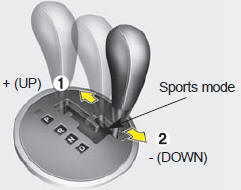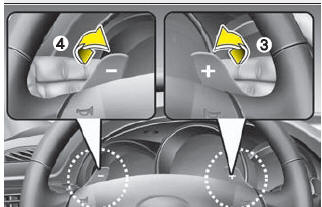Automatic transaxle

Automatic transaxle operation
The highly efficient automatic transaxle has 5 forward speeds and one reverse speed. The individual speeds are selected automatically, depending on the position of the shift lever.
All normal forward driving is done with the shift lever in the D (Drive) position.
To move the shift lever from the P (Park) position, the brake pedal must be depressed with the ignition switch ON.
NOTICE:
The first few shifts on a new vehicle, if
the battery has been disconnected, may
be somewhat abrupt. This is a normal
condition, and the shifting sequence will
adjust after shifts are cycled a few times
by the TCM (Transaxle Control
Module) or PCM (Powertrain Control
Module).
For smooth operation, depress the brake pedal when shifting from N (Neutral) to a forward or reverse gear.
WARNING:
- Automatic transaxle.
• Always check the surrounding areas near your vehicle for people, especially children, before putting a car into D (Drive) or R (Reverse).
• Before leaving the driver’s seat, always make sure the shift lever is in the P (Park) position; then set the parking brake fully and shut the engine off. Unexpected and sudden vehicle movement can occur if these precautions are not followed in the order identified.
CAUTION:
• To avoid damage to your
transaxle, do not accelerate the
engine in R (Reverse) or any forward
gear position with the
brakes on.
• When stopped on an upgrade, do not hold the vehicle stationary with engine power. Use the service brake or the parking brake.
• Do not shift from N (Neutral) or P (Park) into D (Drive), or R (Reverse) when the engine is above idle speed.
Transaxle ranges
The indicator lights in the instrument cluster displays the shift lever position when the ignition switch is in the ON position.
P (Park)
Always come to a complete stop before shifting into P (Park). This position locks the transaxle and prevents the front wheels from rotating.
WARNING:
• Shifting into P (Park) while the
vehicle is in motion will cause the
drive wheels to lock which will
cause you to lose control of the
vehicle.
• Do not use the P (Park) position in place of the parking brake.
Always make sure the shift lever is latched in the P (Park) position and set the parking brake fully.
• Before leaving the driver’s seat, always make sure the shift lever is in the P (Park) position. Set the parking brake fully, shut the engine off and take the key with you. Unexpected and sudden vehicle movement can occur if you do not follow these precautions in the order specified.
• Never leave a child unattended in a vehicle.
CAUTION:
The transaxle may be damaged if
you shift into P (Park) while the
vehicle is in motion.
R (Reverse)
Use this position to drive the vehicle backward.
CAUTION:
Always come to a complete stop
before shifting into or out of R
(Reverse); you may damage the
transaxle if you shift into R while
the vehicle is in motion, except as
explained in “Rocking the Vehicle”,
in this manual.
N (Neutral)
The wheels and transaxle are not locked.
The vehicle will roll freely even on the slightest incline unless the parking brake or service brakes are applied.
D (Drive)
This is the normal forward driving position.
The transaxle will automatically shift through a 5-gear sequence, providing the best fuel economy and power.
Bring the car to a complete stop before shifting the selector to “D” position.
For extra power when passing another vehicle or climbing grades, depress the accelerator fully, at which time the transaxle will automatically downshift to the next lower gear.


Sports mode
Whether the vehicle is stationary or in motion, sports mode is selected by pushing the shift lever from the D (Drive) position into the manual gate. To return to D (Drive) range operation, push the shift lever back into the main gate.
In sport mode, it is possible to shift the gear by using either the shift lever or the steering wheel shift paddles (dynamic shift).
Using the shift lever
Up (+) : Push the lever forward once to shift up one gear (1).
Down (-) : Pull the lever backwards once to shift down one gear (2).
Using the steering wheel shift paddles
Up (+) : Pull the right-hand shift paddle once to shift up one gear (3).
Down (-) : Pull the left-hand shift paddle once to shift down one gear (4).
NOTICE:
When the shift lever is in the P, N or R
position, you can't shift the gear by
using the steering wheel shift paddles.
In sports mode, if you pull the left and right hand shift paddles at the same time, you can't shift the gear.
NOTICE:
• In sports mode, the driver must execute
upshifts in accordance with road
conditions, taking care to keep the
engine speed below the red zone.
• In sports mode, only the 5 forward gears can be selected. To reverse or park the vehicle, move the shift lever to the R (Reverse) or P (Park) position as required.
• In sports mode, downshifts are made automatically when the vehicle slows down. When the vehicle stops, 1st gear is automatically selected.
• In sports mode, when the engine rpm approaches the red zone shift points are varied to upshift automatically.
• To maintain the required levels of vehicle performance and safety, the system may not execute certain gearshifts when the shift lever is operated.
• When driving on a slippery road, push the shift lever forward into the +(up) position or pull the right-hand shift paddle. This causes the transmission to shift into the 2nd gear which is better for smooth driving on a slippery road. Push the shift lever to the - (down) side or pull the left-hand shift paddle to shift back to the 1st gear.
• By rapidly moving the shift lever backwards (-) twice it is possible to skip one gear, i.e., 3rd to 1st, 4th to 2nd or 5th to 3rd. Since sudden engine braking and/or rapid acceleration can cause a loss of traction, however, downshifts must be made carefully in accordance with the vehicle's speed.
Shift lock system (if equipped)
For your safety, the automatic transaxle has a shift lock system which prevents shifting the transaxle out of P (Park) unless the brake pedal is depressed.
To shift the transaxle out of P (Park): 1. Depress and hold the brake pedal.
2. Start the engine or turn the ignition switch to the ON position.
3. Move the shift lever.
If the brake pedal is repeatedly depressed and released with the shift lever in the P (Park) position, a chattering noise near the shift lever may be heard.
This is a normal condition.
WARNING:
Always fully depress the brake
pedal before and while shifting out
of the P (Park) position into another
position to avoid inadvertent
motion of the vehicle which could
injure persons in or around the car.

Shift-lock override
If the shift lever cannot be moved from the P (Park) position with the brake pedal depressed, continue depressing the brake, then do the following: 1. Press the shift-lock release button (1).
2. Move the shift lever.
3. Have your vehicle inspected by an authorized KIA dealer immediately.
Ignition key interlock system (if equipped)
The ignition key cannot be removed unless the shift lever is in the P (Park) position. If the ignition switch is in any other position, the key cannot be removed.
Good driving practices
• Never move the gear selector lever from P (Park) or N (Neutral) to any other position with the accelerator pedal depressed.
• Never move the gear selector lever into P (Park) when the vehicle is in motion.
• Be sure the car is completely stopped before you attempt to shift into R (Reverse) or D (Drive).
• Never take the car out of gear and coast down a hill. This may be extremely hazardous. Always leave the car in gear when moving.
• Do not "ride" the brakes. This can cause them to overheat and malfunction.
Instead, when you are driving down a long hill, slow down and shift to a lower gear. When you do this, engine braking will help slow the car.
• Slow down before shifting to a lower gear. Otherwise, the lower gear may not be engaged.
• Always use the parking brake. Do not depend on placing the transaxle in P (Park) to keep the car from moving.
• Exercise extreme caution when driving on a slippery surface. Be especially careful when braking, accelerating or shifting gears. On a slippery surface, an abrupt change in vehicle speed can cause the drive wheels to lose traction and the vehicle to go out of control.
• Optimum vehicle performance and economy is obtained by smoothly depressing and releasing the accelerator pedal.
WARNING:
• Always buckle-up! In a collision,
an unbelted occupant is significantly
more likely to be seriously
injured or killed than a properly
belted occupant.
• Avoid high speeds when cornering or turning.
• Do not make quick steering wheel movements, such as sharp lane changes or fast, sharp turns.
• The risk of rollover is greatly increased if you lose control of your vehicle at highway speeds.
• Loss of control often occurs if two or more wheels drop off the roadway and the driver oversteers to reenter the roadway.
• In the event your vehicle leaves the roadway, do not steer sharply.
Instead, slow down before pulling back into the travel lanes.
• Never exceed posted speed limits.
WARNING:
If your vehicle becomes stuck in
snow, mud, sand, etc., then you
may attempt to rock the vehicle free
by moving it forward and backward.
Do not attempt this procedure if people or objects are anywhere near the vehicle. During the rocking operation the vehicle may suddenly move forward of backward as it becomes unstuck, causing injury or damage to nearby people or objects.
Moving up a steep grade from a standing start
To move up a steep grade from a standing start, depress the brake pedal, shift the shift lever to D (Drive). Select the appropriate gear depending on load weight and steepness of the grade, and release the parking brake. Depress the accelerator gradually while releasing the service brakes.
When accelerating from a stop on a steep hill, the vehicle may have a tendency to roll backwards. Shifting the shift lever into 2 (Second Gear) will help prevent the vehicle from rolling backwards.
See also:
Packed Cabin
But what the Forte five-door lacks in dynamic refinement is perhaps made up
for with creature comforts. Starting at $19,090, the five-door Forte SX has
everything from the $17,590 EX—including p ...
Introduction
Let's just get to the point here: The 2007 Kia Sorento is a great choice if
you're shopping for a midsize SUV with available four-wheel drive and towing
capabilities. For fewer than $25,000, you c ...
Wipers and washers
Windshield wiper/washer
Rear window wiper/washer (if equipped)
A : Wiper speed control
· MIST – Single wipe
· OFF – Off
· INT – Intermittent wipe
· LO – Low wiper speed
· HI †...


